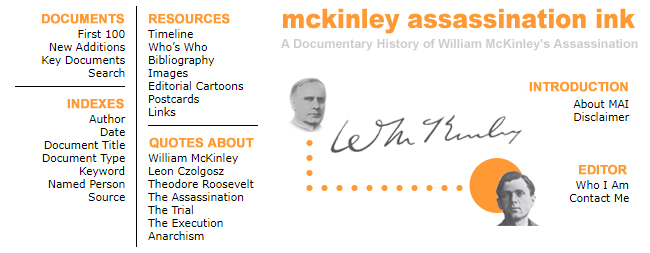|
The Story of an Eye-Witness to the Shooting of
the President
IN THE capacity of Exposition representative
of the Buffalo “Morning Review” I was called upon to cover the visit
of President McKinley to the Pan-American Exposition on that memorable
Friday when the Chief Executive of this great nation was stricken
by an assassin.
Outside the Temple of Music was a
dense crowd, fully fifteen thousand in number, all attracted there
by the President’s reception.
Once the President’s party were well
inside the building, the doors were closed to allow time to make
complete preparations for the levee. The chairs had been peculiarly
arranged, leaving a lane from the southeast entrance of the building
to the southwest exit, through which the people were to pass. It
was scarcely large enough for the passage of more than one file
of people. Under the majestic dome of the building, and bordering
the passageway, a small space had been cleared. Here the President
stood. In line, along each side of the passageway, were the eighteen
members of the artillery corps detachment. In company with three
other newspaper men, I stood in the rear of the President and to
the right of the floral decorations.
When everything had been arranged
the signal was given and a guard opened the southeast door. Outside
there was a detail of at least twenty Exposition policemen regulating
the influx and maintaining the single column. It was exactly at
four o’clock. Everybody seemed to be happy, and the President particularly
so. He beamed on every one in line and had a kind word for all.
Even at this time the assassin must have been within the Temple.
I saw him myself but a minute later. Nothing about his person especially
attracted me; I just glanced at him, that was all. He appeared to
be a kindly disposed German boy, and had a decided Teutonic complexion
that could not be mistaken.
THE TRAGEDY
The last persons to shake hands with
the President were a woman and a little girl, and a negro. I had
just consulted my watch, desiring to take the exact time on some
little incident that had occurred, and which I do not now recall,
for I never recorded the notes. It was exactly 4.07 o’clock. Suddenly
I saw a hand shoved toward the President—two of them in fact—as
if the person wished to grasp the President’s hand in both his own.
In the palm of one hand, the right one, was a handkerchief. Then
there were two shots in rapid succession, the interval being so
short as to be scarcely measurable.
I stood stockstill. I saw Detective
Foster strike upward the hand that would fire the third shot, and
then saw a soldier (Private O’Brien of the Artillery Corps, it afterward
developed) seize the man from behind and drag him down. Then I saw
Gallaher and Ireland jump to the side of Foster, who was then on
his knees with his fingers about the throat of the assassin. I took
two or three steps toward the President. He had turned about a little
and fell into the arms of Detective Geary. Mr. Milburn supported
him from the other side. Just a few drops of blood spurted out and
dropped on his white waistcoat. I remember this distinctly. The
President was led to a chair a dozen steps away, and into this he
sank, exhausted. His collar and necktie were quickly loosed and
his shirt opened at the front. I was considerably excited, inasmuch
as the shooting appealed to me, to use what may seem to be a heartless
expression, in a business way. I was a newspaper man, and there
for the sole purpose of covering the story. I might look at it from
a sentimental viewpoint later. I did not know which to follow, the
President or the assassin. Then I concluded to follow the President.
I walked to his side, and, seeing the others using their hats in
lieu of fans, did the same with mine. Secretary Cortelyou was bending
over him, and distinctly I heard the President say: “Cortelyou,
be careful. Tell Mrs. McKinley gently.”
At this juncture I rushed to where
the assassin lay prostrate on the floor. A dozen or more men, detectives
and guards, were standing over him, striking and kicking him.
I then hastened back to the side of
the President’s chair. He had just raised his eyes, and observed
the rough treatment being accorded his would-be assassin. Raising
his right hand slightly he said:
“See that no one hurts him.”
Some person with more forethought
than others had immediately ordered the doors closed to keep out
the crowd. This was done, and the doors were bolted. Outside the
immense concourse of people was ignorant of what had happened. There
was a murmur of discontent at the closing of the doors. They little
imagined that, within, the President was writhing in pain, the victim
of an anarchist’s bullet. Not even when the ambulance dashed up
to the southwest door of the Temple did they comprehend what had
happened—it was so incredible. They thought some woman had fainted
and the doors were closed pending her removal. The doctors rushed
into the building, and Dr. Ellis felt the pulse. Upon the suggestion
of Mr. Milburn, the coat was removed and the President laid on the
litter. When the doctors and Mr. Milburn appeared at the door bearing
the wounded President a heart-rending sigh went up—such as I have
never heard nor ever expect to hear again. Even then the people
could scarcely believe that the President had been shot. With the
realization of the fact came tears and wailing.
|

